Various trips were offered to the guests on Saturday and Doctor Hla Tun had suggested that I take the all-day trip to Mount Popa, home of the 37 Nats (spirits).
I had first visited Mount Popa in 2009, described here. Impressed, I returned in 2011, this time staying at Mount Popa Resort. That visit is described in two posts here and here. Then, in 2015, during a visit to schools in Bagan area, we went to Mount Popa village for lunch and views of Taung Kalat, as described here.
We set off in a small coach, travelling first to Nyaung Oo and then taking the main road towards Mount Popa. After about half an hour, we stopped at the same toddy palm plantation I'd first visited in 2009, but it was clear that they'd scaled-up the tourist facilities since that visit. A good-tempered ox was still demonstrating how peanuts are ground in an oversize pestle and mortar to extract the oil, leaving behind a biscuit-like solid. This is a treat for the ox, apparently, and I was handed a piece to give to the animal which very gently took it from my fingers with obvious relish.
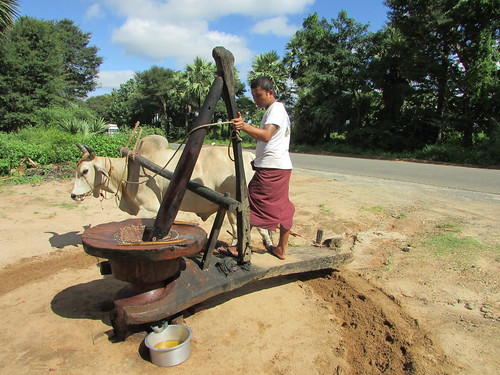 Trip to Mount Popa: Grinding peanuts for oil.
Trip to Mount Popa: Grinding peanuts for oil.
The oil is processed by heating in a large shallow pan (like a wok) whilst continuously stirring. Heat is provided by a simple brick oven fired by bamboo waste and ending in a brick chimney. The oven accommodates a number of pans which are progressively moved towards the chimney as evaporation takes place. Finally, the pan nearest the chimney holds a paste which is carried to a nearby low table to be formed, by hand, into a variety of sweetmeats. Once the pans are moved up, another pan of unprocessed oil can be placed on the oven.
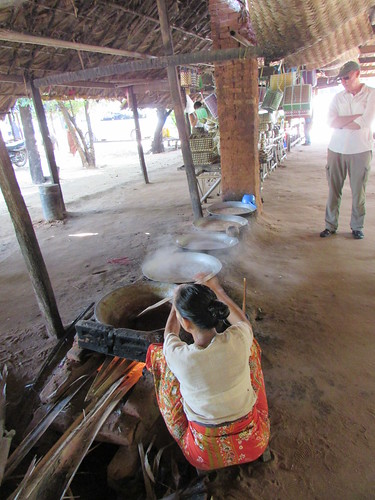
Trip to Mount Popa: Evaporating peanut oil.
Next, a man demonstrated how the toddy palms are climbed once or twice a day, using a simple bamboo ladder lashed to the trunk. A large knife is used to score the tree so that the sap runs into a series of small earthenware pots attached to the tree. On the next visit, the pots containing sap are collected and replaced with empty pots.
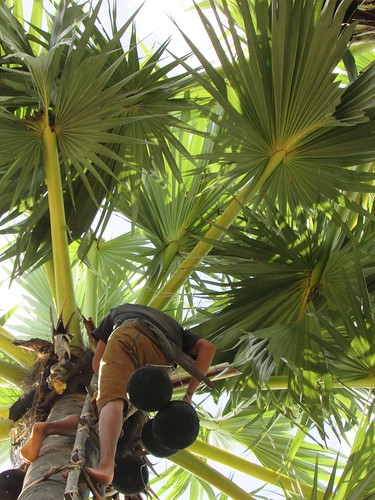
Trip to Mount Popa: Sap collection by exchanging earthenware pots at the top of a toddy palm.
The toddy sap is also taken to the large bamboo shelter where simple stills are used to produce a popular alcoholic drink. The sap is processed by heating in a modified earthenware pot mounted on a simple brick oven fired by bamboo waste and ending in a brick chimney. The oven typically accommodates three pots.
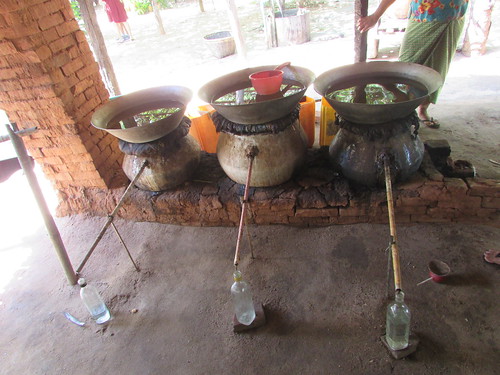
Trip to Mount Popa: Toddy Still.
Each pot is modified by being fitted internally with a metal scoop connected to a long, inclined delivery tube passing through a hole in the side of the pot which is then sealed. The top of the pot is provided with a flexible ring so that, when a large pan of cool water is placed on top of the ring, vapour does not escape.
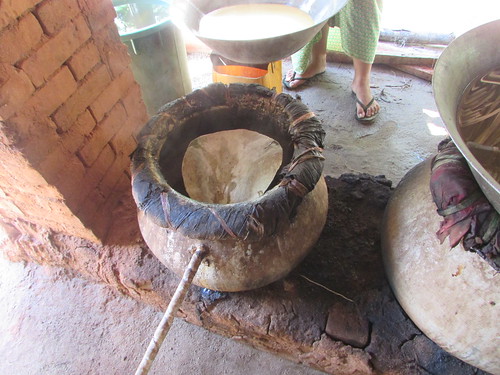
Trip to Mount Popa: Construction of toddy still.
In use, the sap is evaporated by heating but when the vapour strikes the cool underside of the large pan of cool water, the alcohol condenses, droplets fall into the metal scoop and are led away by the inclined tube to a waiting bottle.
All this sweet making and distilling activity requires an army of women fetching and carrying, stirring, firing the ovens, all the time watched by tourists. While we were there, a large coach arrived with a party of tourists from the Australian APT Company, each wearing professional badges showing their first name.
After a fascinating visit, we carried on to Mount Popa, passing through a remote country area where, as I've noted before, many poor and elderly people choose to beg for alms apparently as a way of life, relying upon the Burmese tradition of charitable giving. We parked near the centre of the always-busy town of Mount Popa and walked to the Temple of the Nats, which was oddly quiet when we entered but quickly filled with pilgrims and tourists.
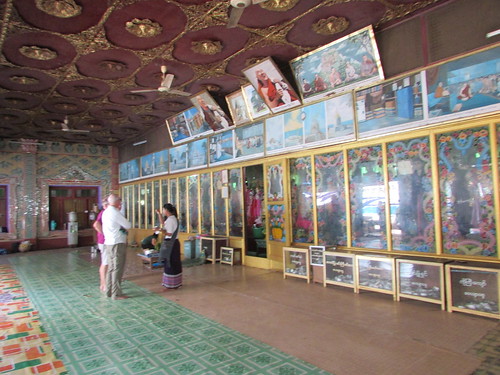
Trip to Mount Popa: The Temple of the Nats.
Images of the 37 Nats are displayed along one long wall of the temple, separated from the main area by a glazed partition which was open for visitors, allowing pilgrims to make donations of money or fresh fruit.
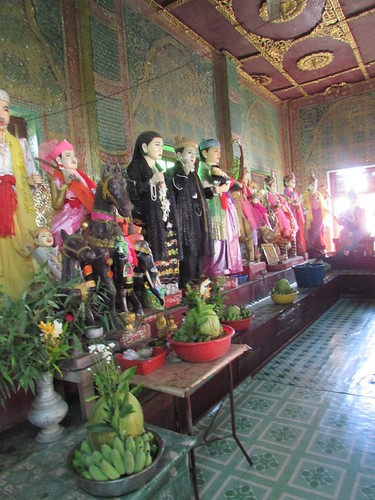
Trip to Mount Popa: Images of the 37 Nats.
The entrance to Taung Kalat, the remarkable series of shrines 777 steps up an improbable-looking rock outcrop populated by hordes of mischievous monkeys was nearby. Having been to the top at least twice, I excused myself as the rest of our party ascended to the summit, instead confining myself to exploring the lower levels occupied by numerous small traders, accompanied by our guide Pyae Pyae. When the party was together again, our coach took the road acending Mount Popa leading to Mount Popa Resort. Pyae Pyae and I started a leisurely lunch on the open air dining deck which offered stunning views of Taung Kalat.
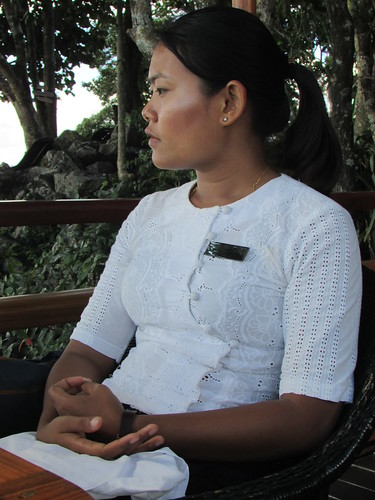
Trip to Mount Popa: Our guide, Pyae Pyae, displaying the natural grace of Myanmar people.
The rest of our party elected to swim in the resort's infinity pool before taking lunch.
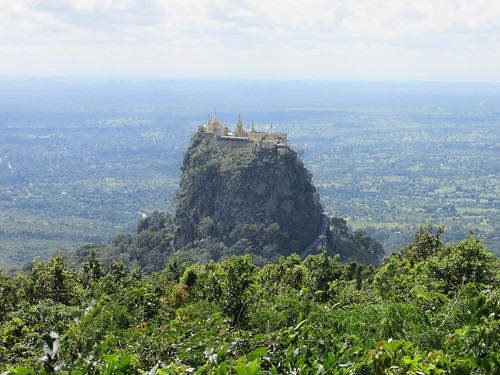
Trip to Mount Popa: Taung Kalat, viewed from Mount Popa Resort.
After lunch, we climbed back into our coach for the return journey. Brian and Shannon had already left 'Road to Mandalay' and were continuing their exploration of Bagan using the Royal Bagan Hotel in Nyaung Oo as their base. So, we dropped them at their hotel before saying "good bye" and returning to Bagan.
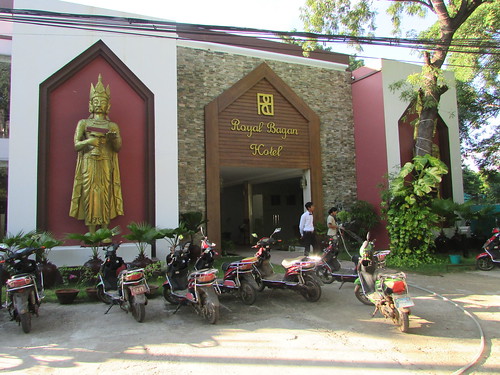
Trip to Mount Popa: Royal Bagan Hotel, Nyaung Oo. Note the waiting 'e-bikes'.
I walked to the Bagan Clinic and, of course, Doctor Hla Tun was still busy with consultations. I was surprised that the open area between a number of the clinic buildings had been provided during the day with a roof of woven plastic netting which I'm sure was appreciated by waiting patients.
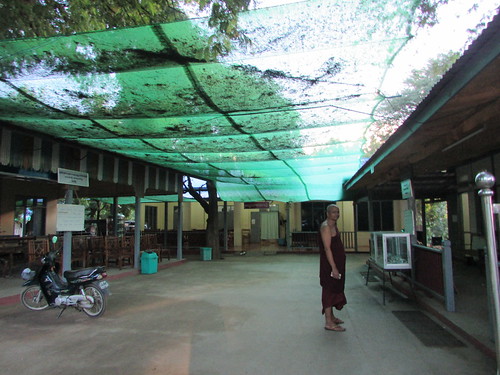
Bagan Medical Clinic Saturday: The Monk beneath the just-installed green netting.
Before I returned to the comfort of 'Road to Mandalay', there was one more experience for me. For some years, I had admired the Irrawaddy Paddle Steamer laid-up at the river bank just below the Clinic and wondered how much of the original machinery survived. Well, Doctor Hla Tun told me that the monk from the Clinic had arranged a visit for me so, armed with my camera, the monk and I descended to the mooring before the light was completely lost. Boarding required negotiation of the long, rather narrow, unsupported gangplank above the brown waters of the Irrawaddy, which task I completed safely but not without some trepidation. Once aboard and seeing that the triple-expansion steam engine and all the associated equipment was intact (if dusty and cobweb bestrewn), I immediately started scurrying up and down companionways with the energy (and lack of grace) of the mountain buffaloes I'd seen in Kachin State lest they should attempt to dissuade me, collecting as many pictures as possible for later study. In due course, there will no doubt be a more technical post on this 1948 Yarrow-built survivor.
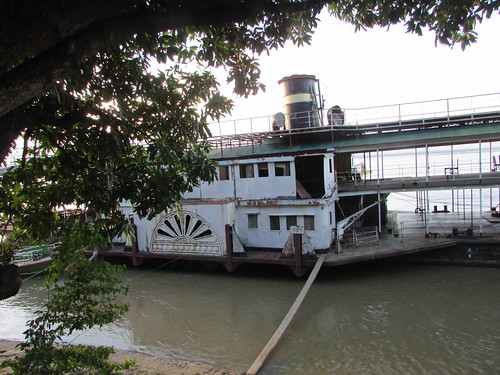
Paddle Steamer 'Minthamee', Bagan 2017: Boarding the Paddle Steamer required negotiation of the long, rather narrow, unsupported gangplank.
Related posts on this website
This is one of a series of posts describing my 12th visit to Myanmar. The post Starting out is the first post in the series.
Clicking on the 'Next report' link displays the post describing the next events. In this way, you may read about the trip in sequence.
Next report.
Alternately, clicking on the 'All my Burma-2017(2) reports' link displays all the posts on this trip in reverse date-of-posting order.
All my Burma-2017(2) reports.
My photograph albums
Where necessary, clicking on an image above will display an 'uncropped' view or, alternately, pictures may be selected, viewed or downloaded, in various sizes, from the albums listed:-
'Road to Mandalay': October 2017.
Trip to Mount Popa.
Paddle Steamer 'Minthamee', Bagan..
